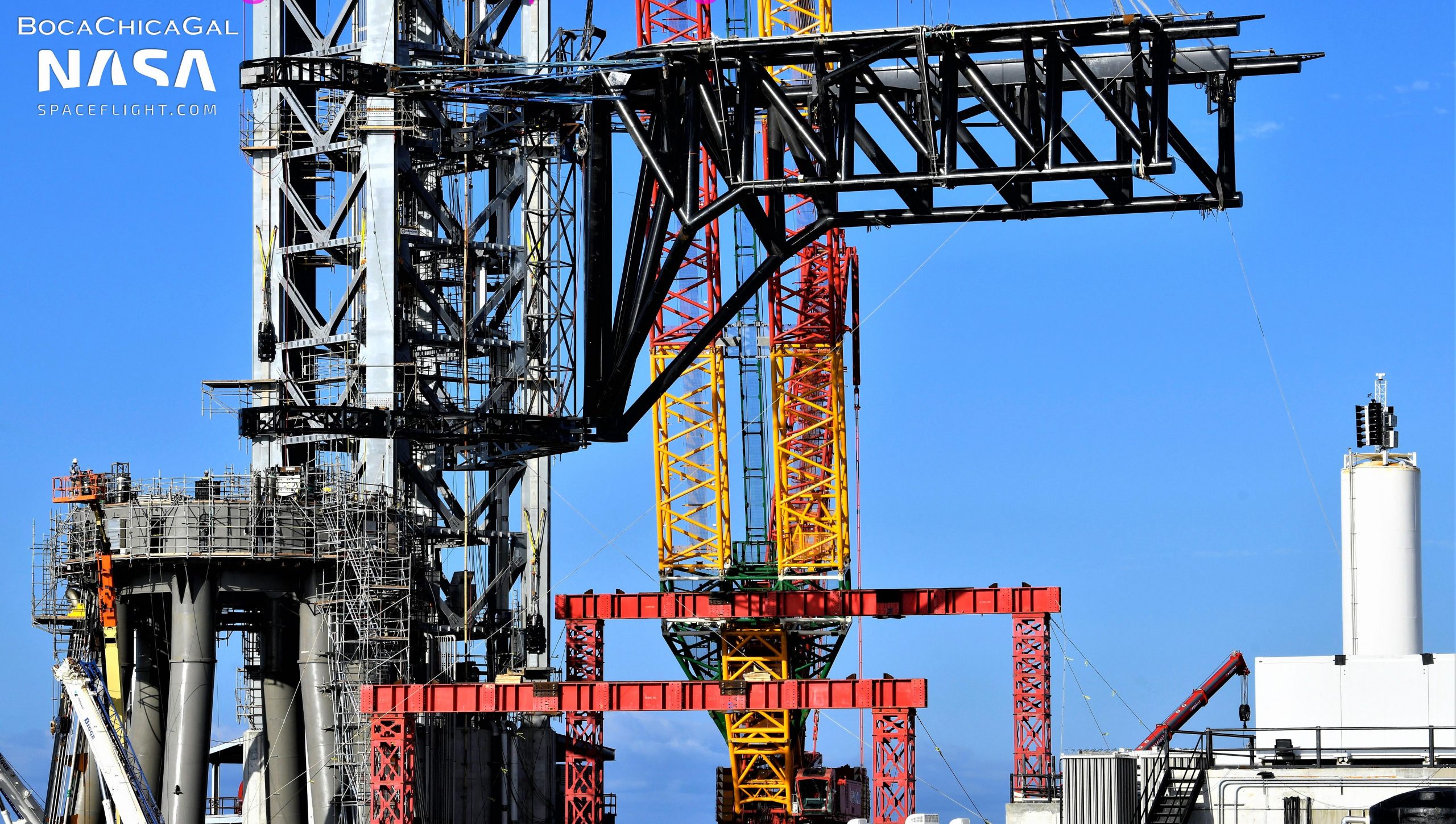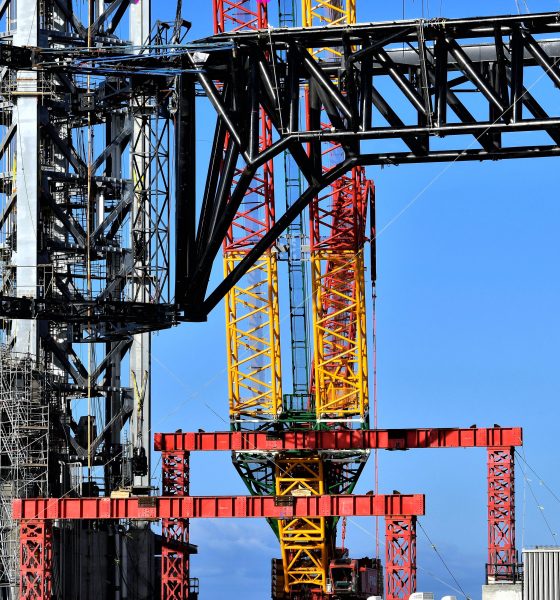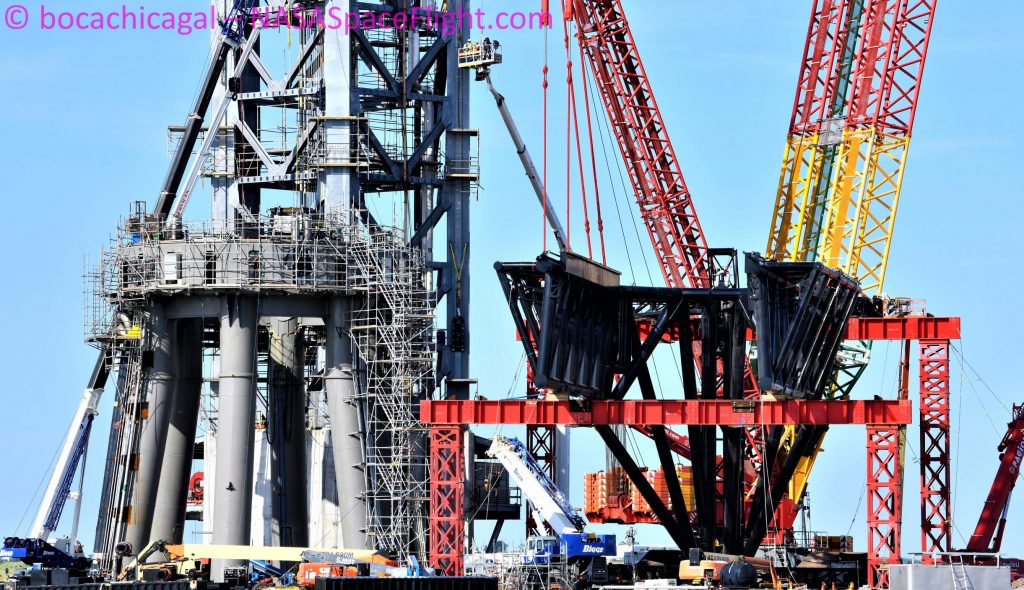

News
SpaceX begins installing ‘Mechazilla’ arms designed to catch Starship rockets
After a busy few weeks spent attaching Mechazilla’s two rocket-catching arms to a carriage-like backbone, SpaceX has begun the process of installing the integrated structure on Starbase’s ~450 ft (~135m) tall Starship ‘launch tower’.
Once complete, SpaceX will have created a first-of-its-kind launch tower designed to stack and manipulate Starships and Super Heavy boosters in far worse conditions than cranes can tolerate and catch both rocket stages out of mid-air. Referred to internally as ‘chopsticks,’ the giant pair of steel arms will join a third ‘quick disconnect’ (QD) arm tasked with stabilizing Super Heavy during Starship installation and feeding the reusable upper stage power, comms links, and some 1200 tons (~2.65M lb) of propellant.
Together, they will enable SpaceX to attempt Starship’s first orbital test flights and, perhaps one day, help the next-generation rocket launch in almost any weather and achieve unprecedentedly rapid reusability. But first, SpaceX needs to finish installing and rigging the massive structure.
Beginning on August 29th after less than three months of assembly, SpaceX installed Starship’s QD arm on the launch tower. About a month later, the QD arm was mostly finished off with the installation of a claw-like grabber meant to stabilize Super Heavy and is now only missing its namesake quick-disconnect (an actuating device that will connect Starship to the pad and rapidly disconnect at liftoff). Assembly of the last three major components of Mechazilla – a carriage-like structure and two giant arms – began in July and, much like the tower’s QD arm, wrapped up about three months later.
On October 6th, SpaceX began combining those three main parts by flipping the carriage – a bit like a spine and ribcage with ‘skates’ that attach to rails on the launch tower’s legs – vertical and staging it on a temporary support structure. Both ‘chopsticks’ were then flipped into the correct orientation and moved into position with separate cranes for installation on the carriage/backbone. From start to finish, that process took around 9-10 days and culminated with the installation of two giant cylindrical pins with built-in bearings on October 14th and 15th. By the 17th, both cranes had detached from the assembled Mechazilla arms and carriage were, leaving it precisely balanced against the support structure and more or less freestanding.


Just a few days later, after a last-second attempt on October 19th was called off as night fell, SpaceX tried again on the 20th and completed the first step of installing Mechazilla’s catch arms on the launch tower without apparent issue. Likely weighing several hundred tons, Starbase’s largest crane lifted the massive structure up and over an adjacent launch mount and then carefully inched it closer to the tower. Prior to the lift, SpaceX technicians staged 12 ‘skates’ on three of the tower’s four legs – two upper and two lower skates per leg.
Here's one with the QD arm back. If QD engaged, chopsticks can't get past. Elon said only need for "ship mate". Chopstick sequence:
1. Lift SH onto OLM
2. Rise, swing to side, lower, grasp SS
3. Rise above SH
4. Deploy QD arm and claw
5. Lower SS onto SH
6. At launch, open wide! pic.twitter.com/iRRfXQ5uEn— LunarCaveman (@LunarCaveman) October 1, 2021
Once the carriage was in the right position, workers were able to wrap its upper arms around the tower and began connecting the carriage to those skates with several more large pins. It’s unclear how much progress was made in the hours after the lift but it appears that the carriage has been attached to maybe four or five of six upper skates. Work continued well after nightfall, meaning that it will likely only take a few days to complete all 12 connections. However, even after all skates are installed, the carriage, arms, and skates will still be hanging by crane or winch.
To truly install the structure on the tower, SpaceX will have to finish installing and rigging thousands of feet of steel cable that – via a complex system of pulleys – will connect to powered ‘drawworks’ that will support the carriage and catch arms and lift the assembly up and down the tower like an elevator car. The catch arms and carriage will also need to be mated with a giant ‘cable carrier’ (already staged on the tower) that will connect the structure to ground and control systems.

News
NVIDIA Director of Robotics: Tesla FSD v14 is the first AI to pass the “Physical Turing Test”
After testing FSD v14, Fan stated that his experience with FSD felt magical at first, but it soon started to feel like a routine.

NVIDIA Director of Robotics Jim Fan has praised Tesla’s Full Self-Driving (Supervised) v14 as the first AI to pass what he described as a “Physical Turing Test.”
After testing FSD v14, Fan stated that his experience with FSD felt magical at first, but it soon started to feel like a routine. And just like smartphones today, removing it now would “actively hurt.”
Jim Fan’s hands-on FSD v14 impressions
Fan, a leading researcher in embodied AI who is currently solving Physical AI at NVIDIA and spearheading the company’s Project GR00T initiative, noted that he actually was late to the Tesla game. He was, however, one of the first to try out FSD v14.
“I was very late to own a Tesla but among the earliest to try out FSD v14. It’s perhaps the first time I experience an AI that passes the Physical Turing Test: after a long day at work, you press a button, lay back, and couldn’t tell if a neural net or a human drove you home,” Fan wrote in a post on X.
Fan added: “Despite knowing exactly how robot learning works, I still find it magical watching the steering wheel turn by itself. First it feels surreal, next it becomes routine. Then, like the smartphone, taking it away actively hurts. This is how humanity gets rewired and glued to god-like technologies.”
The Physical Turing Test
The original Turing Test was conceived by Alan Turing in 1950, and it was aimed at determining if a machine could exhibit behavior that is equivalent to or indistinguishable from a human. By focusing on text-based conversations, the original Turing Test set a high bar for natural language processing and machine learning.
This test has been passed by today’s large language models. However, the capability to converse in a humanlike manner is a completely different challenge from performing real-world problem-solving or physical interactions. Thus, Fan introduced the Physical Turing Test, which challenges AI systems to demonstrate intelligence through physical actions.
Based on Fan’s comments, Tesla has demonstrated these intelligent physical actions with FSD v14. Elon Musk agreed with the NVIDIA executive, stating in a post on X that with FSD v14, “you can sense the sentience maturing.” Musk also praised Tesla AI, calling it the best “real-world AI” today.
News
Tesla AI team burns the Christmas midnight oil by releasing FSD v14.2.2.1
The update was released just a day after FSD v14.2.2 started rolling out to customers.

Tesla is burning the midnight oil this Christmas, with the Tesla AI team quietly rolling out Full Self-Driving (Supervised) v14.2.2.1 just a day after FSD v14.2.2 started rolling out to customers.
Tesla owner shares insights on FSD v14.2.2.1
Longtime Tesla owner and FSD tester @BLKMDL3 shared some insights following several drives with FSD v14.2.2.1 in rainy Los Angeles conditions with standing water and faded lane lines. He reported zero steering hesitation or stutter, confident lane changes, and maneuvers executed with precision that evoked the performance of Tesla’s driverless Robotaxis in Austin.
Parking performance impressed, with most spots nailed perfectly, including tight, sharp turns, in single attempts without shaky steering. One minor offset happened only due to another vehicle that was parked over the line, which FSD accommodated by a few extra inches. In rain that typically erases road markings, FSD visualized lanes and turn lines better than humans, positioning itself flawlessly when entering new streets as well.
“Took it up a dark, wet, and twisty canyon road up and down the hill tonight and it went very well as to be expected. Stayed centered in the lane, kept speed well and gives a confidence inspiring steering feel where it handles these curvy roads better than the majority of human drivers,” the Tesla owner wrote in a post on X.
Tesla’s FSD v14.2.2 update
Just a day before FSD v14.2.2.1’s release, Tesla rolled out FSD v14.2.2, which was focused on smoother real-world performance, better obstacle awareness, and precise end-of-trip routing. According to the update’s release notes, FSD v14.2.2 upgrades the vision encoder neural network with higher resolution features, enhancing detection of emergency vehicles, road obstacles, and human gestures.
New Arrival Options also allowed users to select preferred drop-off styles, such as Parking Lot, Street, Driveway, Parking Garage, or Curbside, with the navigation pin automatically adjusting to the ideal spot. Other refinements include pulling over for emergency vehicles, real-time vision-based detours for blocked roads, improved gate and debris handling, and Speed Profiles for customized driving styles.
Elon Musk
Elon Musk’s Grok records lowest hallucination rate in AI reliability study
Grok achieved an 8% hallucination rate, 4.5 customer rating, 3.5 consistency, and 0.07% downtime, resulting in an overall risk score of just 6.

A December 2025 study by casino games aggregator Relum has identified Elon Musk’s Grok as one of the most reliable AI chatbots for workplace use, boasting the lowest hallucination rate at just 8% among the 10 major models tested.
In comparison, market leader ChatGPT registered one of the highest hallucination rates at 35%, just behind Google’s Gemini, which registered a high hallucination rate of 38%. The findings highlight Grok’s factual prowess despite the AI model’s lower market visibility.
Grok tops hallucination metric
The research evaluated chatbots on hallucination rate, customer ratings, response consistency, and downtime rate. The chatbots were then assigned a reliability risk score from 0 to 99, with higher scores indicating bigger problems.
Grok achieved an 8% hallucination rate, 4.5 customer rating, 3.5 consistency, and 0.07% downtime, resulting in an overall risk score of just 6. DeepSeek followed closely with 14% hallucinations and zero downtime for a stellar risk score of 4. ChatGPT’s high hallucination and downtime rates gave it the top risk score of 99, followed by Claude and Meta AI, which earned reliability risk scores of 75 and 70, respectively.

Why low hallucinations matter
Relum Chief Product Officer Razvan-Lucian Haiduc shared his thoughts about the study’s findings. “About 65% of US companies now use AI chatbots in their daily work, and nearly 45% of employees admit they’ve shared sensitive company information with these tools. These numbers show well how important chatbots have become in everyday work.
“Dependence on AI tools will likely increase even more, so companies should choose their chatbots based on how reliable and fit they are for their specific business needs. A chatbot that everyone uses isn’t necessarily the one that works best for your industry or gives accurate answers for your tasks.”
In a way, the study reveals a notable gap between AI chatbots’ popularity and performance, with Grok’s low hallucination rate positioning it as a strong choice for accuracy-critical applications. This was despite the fact that Grok is not used as much by users, at least compared to more mainstream AI applications such as ChatGPT.








